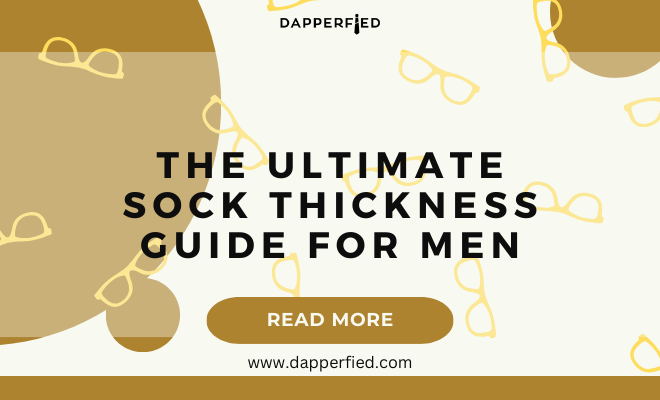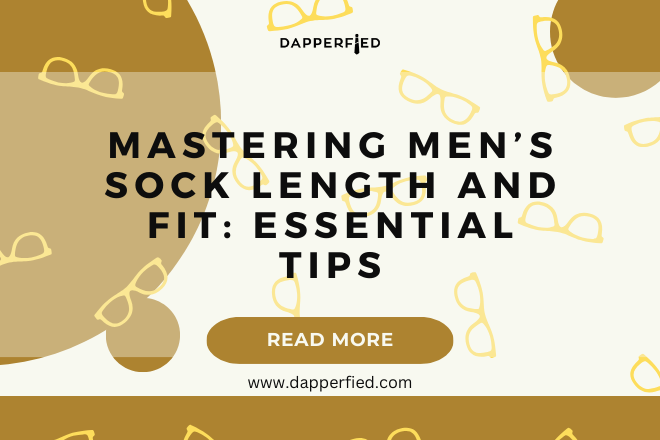
Men's Style
The Ultimate Sock Thickness Guide for Men
Sock thickness is a crucial factor in selecting appropriate footwear. It ranges from ultra-thin to extra thick, with each variation offering distinct advantages. The choice of sock thickness depends on various factors, including the intended activity, shoe type, and personal preferences.
Different sock thicknesses serve various purposes. Thin socks are ideal for dress shoes and formal occasions, while thicker socks provide additional cushioning and insulation for athletic activities or cold weather. Medium-thickness socks offer a balance between comfort and versatility for everyday wear.
When choosing sock thickness, consider the activity you’ll be engaging in. For instance, runners may prefer thinner socks for better shoe fit and reduced friction, while hikers might opt for thicker socks to prevent blisters and provide extra cushioning on rough terrain. Sock thickness should also complement the type of shoe being worn.
Dress shoes typically require thinner socks, while boots and athletic shoes can accommodate thicker options. It’s important to ensure that the sock thickness doesn’t compromise the fit of the shoe. Various materials and fabrics are used in sock manufacturing, each affecting the overall thickness and performance.
Common materials include cotton, wool, synthetic fibers, and blends. These materials influence factors such as moisture-wicking properties, durability, and insulation. Proper care and maintenance of socks are essential for preserving their thickness and overall quality.
This includes following washing instructions, avoiding excessive heat during drying, and replacing socks when they show signs of wear. Understanding the nuances of sock thickness enables individuals to make informed choices that enhance comfort, performance, and foot health across various activities and environments.
Key Takeaways
- Sock thickness can greatly impact comfort and performance during various activities
- Different sock thicknesses offer benefits such as cushioning, moisture-wicking, and temperature regulation
- Choosing the right sock thickness depends on the activity, weather conditions, and personal preference
- Matching sock thickness with different shoe types can improve fit and prevent blisters
- Understanding fabric and material options for sock thickness can help in making informed choices for specific needs and preferences
- Proper care and maintenance of different sock thicknesses can prolong their lifespan and performance
- Finding the perfect sock thickness involves considering activity, weather, shoe type, and personal comfort preferences
Benefits of Different Sock Thicknesses
Choosing the Right Sock Thickness for Your Activity
When it comes to selecting the perfect socks for your activity, the thickness of the sock plays a crucial role. The right thickness can make all the difference in terms of comfort, performance, and overall enjoyment.
Thin Socks for Close-Fitting Activities
Thin socks are ideal for activities that require a close fit and minimal bulk, such as running or cycling. They provide a lightweight and breathable option that helps reduce friction and blisters. Additionally, they offer a snug fit, which can improve the overall feel and performance of your shoes. Thin socks are also great for warm weather or indoor activities where you don’t need extra insulation.
Thick Socks for Cold Weather and High-Impact Activities
Thick socks are perfect for cold weather activities or for individuals who need extra cushioning and support. They provide insulation and warmth, making them ideal for outdoor activities like hiking, skiing, or snowboarding. The extra padding in thick socks can also help absorb impact and reduce fatigue during long periods of standing or walking. Additionally, thick socks can provide added protection against blisters and hot spots, making them a popular choice for athletes and outdoor enthusiasts.
Choosing the Right Sock Thickness for Different Activities
a. Athletic Activities:
When it comes to athletic activities, the right sock thickness can make a significant difference in performance and comfort. For high-intensity sports like running or cycling, thin socks are often preferred as they provide a close fit and minimal bulk, allowing for better shoe contact and reduced friction.
On the other hand, activities that involve impact or prolonged standing, such as hiking or skiing, may benefit from thicker socks that offer extra cushioning and insulation. b. Everyday Wear:
For everyday wear, the choice of sock thickness depends on personal preference and climate.
In warmer weather, thin socks can provide breathability and comfort, while in colder climates, thicker socks can offer warmth and insulation. Consider the type of shoes you’ll be wearing and the level of activity throughout the day when choosing the right sock thickness for everyday wear.
How to Match Sock Thickness with Different Shoe Types
| Shoe Type | Sock Thickness |
|---|---|
| Athletic Shoes | Thin to Medium |
| Dress Shoes | Thin |
| Boots | Thick |
| Sandals | No socks |
a. Athletic Shoes:
When it comes to athletic shoes, the right sock thickness can enhance performance and comfort. For running shoes or cycling shoes, thin socks are often preferred as they provide a close fit and minimal bulk, allowing for better shoe contact and reduced friction.

On the other hand, sports that involve impact or prolonged standing, such as hiking or skiing, may benefit from thicker socks that offer extra cushioning and insulation. b. Casual Shoes:
For casual shoes like sneakers or loafers, the choice of sock thickness depends on personal preference and climate.
In warmer weather, thin socks can provide breathability and comfort, while in colder climates, thicker socks can offer warmth and insulation. Consider the type of shoes you’ll be wearing and the level of activity throughout the day when choosing the right sock thickness for casual shoes.
Understanding Fabric and Material Options for Sock Thickness
a. Cotton:
Cotton socks are a popular choice for their softness and breathability. They are comfortable to wear and provide good moisture absorption.
However, cotton socks may not be the best option for activities that involve a lot of sweating or moisture as they can become heavy and uncomfortable when wet. b. Wool:
Wool socks are known for their warmth and insulation properties.
They are great for cold weather activities as they provide excellent heat retention and moisture-wicking capabilities. Wool socks also have natural antibacterial properties, making them a great choice for odor control.
Tips for Proper Care and Maintenance of Different Sock Thicknesses
Washing Your Socks
It’s essential to follow the care instructions on the label when washing your socks. Some thicker socks may require special care, such as hand washing or air drying, to maintain their shape and elasticity.
Proper Storage Techniques
Proper storage of your socks can help maintain their quality and shape. Avoid folding or stretching your socks when storing them to prevent damage to the elastic fibers.
Tips for Long-Lasting Socks
By following these simple care instructions, you can extend the life of your socks and keep them looking their best. Remember to always check the care label and take the necessary precautions to ensure your socks remain in top condition.
Finding Your Perfect Sock Thickness
In conclusion, finding the perfect sock thickness depends on a variety of factors including activity, climate, shoe type, and personal preference. Understanding the benefits of different sock thicknesses can help you make an informed decision when choosing the right pair of socks for your needs. Whether you’re looking for performance-enhancing athletic socks, extra cushioning for outdoor activities, or simply want to keep your feet warm and cozy, there’s a perfect sock thickness out there for you.

By considering the material options, proper care and maintenance tips, and matching sock thickness with different shoe types, you can ensure that your feet are comfortable and supported in any situation. So go ahead, explore the world of sock thicknesses and find your perfect fit!
If you’re interested in men’s fashion, you may also want to check out this article on men’s cotton suit discussion. It provides valuable insights into the world of men’s suiting and can help you make informed decisions when it comes to your wardrobe.
FAQs
What are the different sock thicknesses for men?
There are generally three main sock thicknesses for men: thin, medium, and thick. Thin socks are typically lightweight and suitable for dress shoes or warmer weather. Medium thickness socks are versatile and can be worn with a variety of shoes and in different weather conditions. Thick socks are designed for colder weather and provide extra warmth and cushioning.
How do I choose the right sock thickness?
When choosing the right sock thickness, consider the weather, the type of shoes you’ll be wearing, and your personal comfort preferences. Thin socks are ideal for dress shoes and warmer weather, while thick socks are best for colder temperatures. Medium thickness socks offer a balance of comfort and versatility.
What are the benefits of thin socks for men?
Thin socks for men are lightweight and breathable, making them ideal for dress shoes and warmer weather. They provide a comfortable fit without adding extra bulk, and are suitable for professional or formal occasions.
What are the benefits of medium thickness socks for men?
Medium thickness socks for men are versatile and can be worn with a variety of shoes and in different weather conditions. They offer a balance of comfort and breathability, making them suitable for everyday wear.
What are the benefits of thick socks for men?
Thick socks for men are designed for colder weather and provide extra warmth and cushioning. They are ideal for outdoor activities, hiking, or wearing with winter boots. Thick socks also provide additional padding and support for the feet.

















